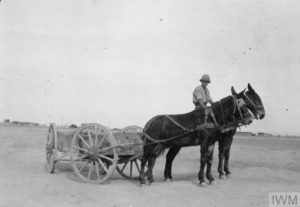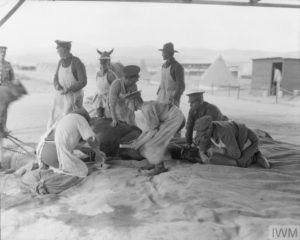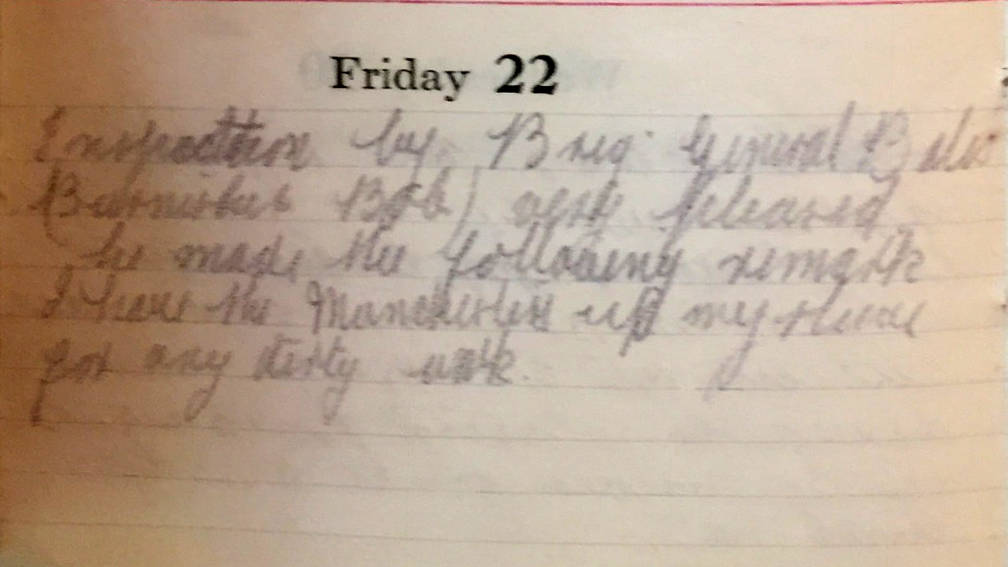Friday March 22nd, 1918
Inspection by Brigadier General FS Montague-Bates (Barnicle Bob ??) very pleased. He made the following remark “I have the Manchesters up my sleeve for any dirty work.”
On Parade

The British are in retreat on the Western Front. In Olasli, the big brass is inspecting the troops. Much has been made in books and contemporary reports of the frustration of those troops in Salonika at not being in the thick of it. This seems to be borne out by Frank’s entry today. He seems buoyed up by the fighting talk of the 66th Brigade’s leader, Brigadier-General FS Montague-Bates. Despite having quite the reputation, we haven’t been able to corroborate the nickname, Barnacle Bob, ascribed by Frank. Any ideas?
The GOC also inspected, commented upon and praised the Battalion and Transport. Prizes have been awarded for the best Limber, Lewis Gun Section and Mules. By way of example, this photograph shows a mule-drawn limber in Egypt in December 1917.
Veterinarians in War
Luigi Villari, Italian liaison officer with various Allied Commands in Macedonia during the war, noted the keenness of the British Army on competitions and parades involving horses, and thought it noteworthy that, if the horses’ tackle and brasses were tarnished, ‘points were removed‘. He went on, ‘…how admirably the British kept their horses and mules, in spite of the enormous difficulties of supply and the terrible scarcity of forage…’¹

There was, however, a very practical aspect to this focus on animal welfare. Despite the presence of motorized cars, lorries and ambulances, the primary means of transport available to the BSF remained horses and mules.
The infrastructure involved in keeping them healthy was enormous. Any unit not taking proper care of its animals was taken to task at the highest levels.
It wasn’t just about food and shelter, but also medical care for any sick and injured animals. A whole network of Veterinarian Services was established. This include vets and farriers working in the field with all Army units (not just the Cavalry), mobile facilities, hospitals, convalescent depots and supply stores. The process for evacuating sick and wounded animals for treatment was as sophisticated as anything for the troops.
The photograph shows the British Army Veterinary Corps staff chloroforming a horse before an operation at a veterinary hospital near Salonika in April 1916.
13th (Service) Battalion War Diary – 22nd March 1918 – No 1 Sector, Olasli
Battalion cleaning up. The GOC inspected the Battalion and Transport. He was pleased with the turn out and especially mentioned the arm drill and steadiness on parade. After inspecting the Battalion the Transport (which was drawn up some distance in rear) was inspected and their condition and turn out complimented. At the finish the GOC judged the winning Limber and team and the Lewis Guns and team. B Coys Limber got the first prize and C Coy got first prize for Lewis Gun Section and Mules. 7 OR having rejoined are again taken on the effective strength from 21-3-18. These are for water duties. The Battalion played the Lothian and Border Horse at Rugby, they were beaten by 19 points to 11 but put up a good fight considering this was the first game the two have played in this country.
References & Further Reading
¹ ‘The Macedonian Campaign’ by Luigi Villari, published in English in 1922 (page 76)
“Military Organisation and Administration” by Major G. R.N. Collins who published a book of lectures, given at the Canadian Military School, in 1918. WWI, The Medical Front.
^ ‘A Soldier & Limber‘, copyright IWM
* ‘Chloroforming a horse‘, copyright IWM


